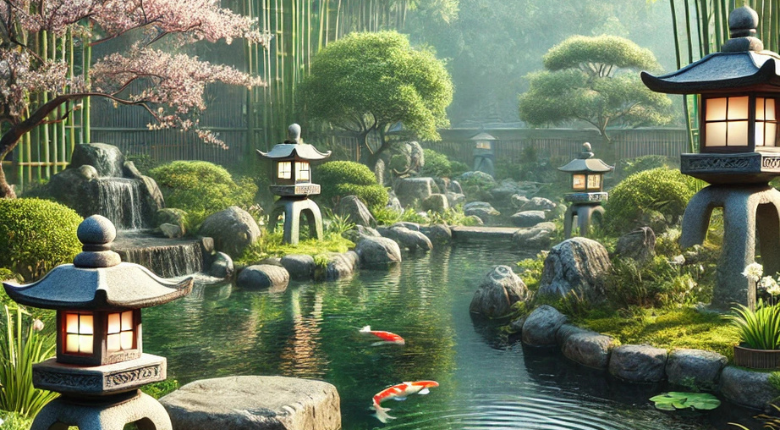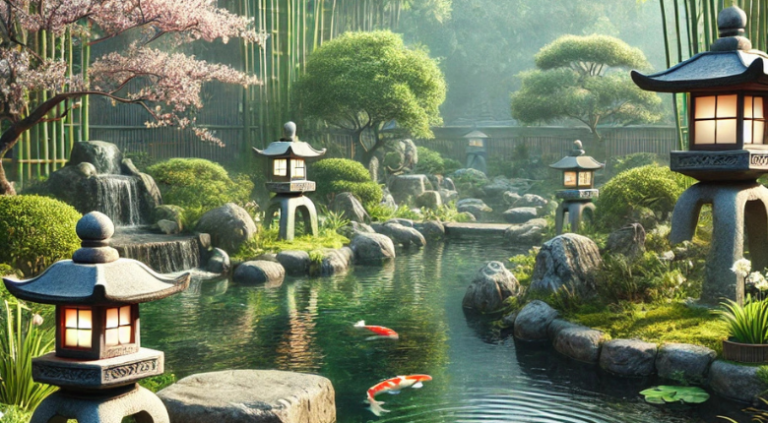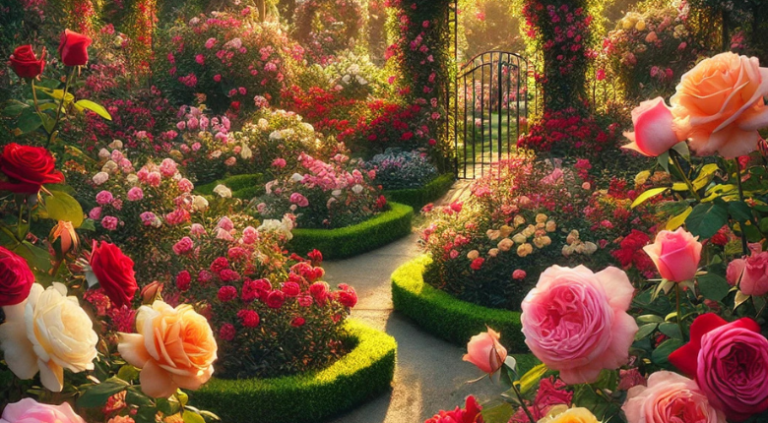Japanese Garden Ideas for Backyard. Are you looking to create a tranquil oasis in your backyard, a space that embodies the principles of serenity and balance? Look no further than a Japanese garden. For centuries, Japanese gardens have been designed to promote relaxation, meditation, and a connection with nature. In this article, we’ll explore the key elements of a Japanese garden, provide a step-by-step guide on how to set one up, and offer 10 simple ideas to get you started.
The Essence of a Japanese Garden
A Japanese garden is more than just a beautifully designed outdoor space; it’s an extension of the home, a place where one can escape the stresses of everyday life and connect with nature. The traditional Japanese garden is designed to promote a sense of calm and tranquility, using natural elements such as water, stone, and plants to create a balanced and harmonious environment.
The concept of a Japanese garden is deeply rooted in the country’s culture and history. The word “garden” in Japanese is “niwa,” which literally means “place of tranquility.” Japanese gardens are designed to be a place of refuge, where one can escape the hustle and bustle of daily life and connect with nature.
10 Simple Japanese Garden Ideas for Backyard
Here are 10 simple ideas to help you create a beautiful Japanese garden:
- Small Koi Pond: Create a small koi pond to add a touch of serenity to your garden.
- Bamboo Fencing: Use bamboo fencing to create a natural and harmonious boundary.
- Raked Gravel Garden: Create a raked gravel garden with rocks and symbolic patterns.
- Miniature Stone Lantern: Add a miniature stone lantern to create a sense of tranquility.
- Japanese Maple Trees: Plant Japanese maple trees to create a stunning focal point.
- Bamboo Water Fountain: Create a bamboo water fountain (shishi-odoshi) to add a soothing sound.
- Stepping Stones with Moss: Use stepping stones with moss to create a natural and harmonious path.
- Small Meditation Corner: Create a small meditation corner with a bench to promote relaxation.
- Moss Garden: Create a moss garden for shaded areas to add a touch of serenity.
- Bonsai Corner: Create a bonsai corner to showcase your miniature tree collection.
How to Set Up a Japanese Garden
Creating a Japanese garden is easier than you think. Here are the essential elements to include:
Water Features
Water Features: Incorporate traditional water features such as ponds, waterfalls, or small streams to create a soothing and calming atmosphere. Water features are an essential element of a Japanese garden, as they help to create a sense of tranquility and relaxation. The sound of running water is also believed to have a calming effect on the mind and body.
When incorporating a water feature into your Japanese garden, consider the following:
- Ponds: A small pond can be a beautiful addition to a Japanese garden. Consider adding a few koi fish to create a sense of movement and life.
- Waterfalls: A small waterfall can create a soothing sound and add visual interest to your garden.
- Streams: A small stream can be a beautiful addition to a Japanese garden, creating a sense of movement and tranquility.
Natural Materials
Natural Materials: Use natural materials such as stone paths, bamboo fences, and wooden bridges to create a sense of harmony with nature. Natural materials are an essential element of a Japanese garden, as they help to create a sense of balance and harmony.
When incorporating natural materials into your Japanese garden, consider the following:
- Stone Paths: A stone path can be a beautiful addition to a Japanese garden, creating a sense of texture and visual interest.
- Bamboo Fences: Bamboo fences are a traditional element of a Japanese garden, creating a sense of natural beauty and harmony.
- Wooden Bridges: A wooden bridge can be a beautiful addition to a Japanese garden, creating a sense of movement and visual interest.
Symbolic Elements
Symbolic Elements: Incorporate symbolic elements such as raked gravel or sand to create a Zen look and promote meditation. Symbolic elements are an essential element of a Japanese garden, as they help to create a sense of balance and harmony.
When incorporating symbolic elements into your Japanese garden, consider the following:
- Raked Gravel: Raked gravel is a traditional element of a Japanese garden, creating a sense of texture and visual interest.
- Sand: Sand is also a traditional element of a Japanese garden, creating a sense of texture and visual interest.
Japanese Plants
Japanese Plants: Add Japanese maples, bamboo, moss, and evergreen plants to create a balanced and harmonious environment. Japanese plants are an essential element of a Japanese garden, as they help to create a sense of balance and harmony.
When incorporating Japanese plants into your garden, consider the following:
- Japanese Maples: Japanese maples are a traditional element of a Japanese garden, creating a sense of natural beauty and harmony.
- Bamboo: Bamboo is a traditional element of a Japanese garden, creating a sense of natural beauty and harmony.
- Moss: Moss is a traditional element of a Japanese garden, creating a sense of texture and visual interest.
- Evergreen Plants: Evergreen plants are a traditional element of a Japanese garden, creating a sense of natural beauty and harmony.
Balanced Layout
Balanced Layout: Create a balanced layout that includes open spaces and shaded areas, promoting a sense of tranquility and relaxation. A balanced layout is an essential element of a Japanese garden, as it helps to create a sense of balance and harmony.
When creating a balanced layout for your Japanese garden, consider the following:
- Open Spaces: Open spaces are an essential element of a Japanese garden, creating a sense of freedom and relaxation.
- Shaded Areas: Shaded areas are an essential element of a Japanese garden, creating a sense of tranquility and relaxation.
Maintenance Tips
Maintaining a Japanese garden is relatively easy, but it does require some effort. Here are some tips to keep your garden looking its best:
- Prune Plants: Regularly prune plants like maples and bamboo to maintain their shape and promote healthy growth.
- Rake Gravel or Sand: Rake gravel or sand to maintain patterns and create a sense of harmony.
- Remove Fallen Leaves: Remove fallen leaves and maintain water features (if any) to keep your garden looking its best.
Budget Breakdown For Japanese Garden
Creating a Japanese garden can be done on a budget. Here’s a breakdown of the costs:
- Low: Gravel, stepping stones, basic plants (~$200-$500)
- Medium: Water features, stone lanterns (~$500-$1,500)
- High: Large koi ponds, professional landscaping (~$1,500+)

Frequently Asked Questions
Here are some frequently asked questions about Japanese gardens:
- What plants are ideal for a Japanese garden?: Japanese maples, bamboo, moss, and evergreen plants are ideal for a Japanese garden.
- How much space do I need for a Japanese garden?: A small space of around 10×10 feet can be sufficient for a Japanese garden.
- Can I add a water feature to a small garden?: Yes, a small water feature such as a miniature pond or fountain can be added to a small garden.
- Is it difficult to maintain a Japanese garden?: No, maintaining a Japanese garden is relatively easy, but it does require some effort.
Recap
Creating a Japanese garden is a great way to add a touch of serenity and tranquility to your outdoor space. By incorporating natural elements such as water, stone, and plants, you can create a balanced and harmonious environment that promotes relaxation and meditation. Remember to keep it simple, natural, and harmonious, and don’t be afraid to experiment and add your own personal touches. With these tips and ideas, you can create a beautiful Japanese garden that will bring you joy and peace for years to come.




